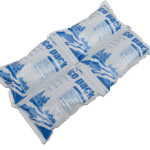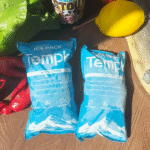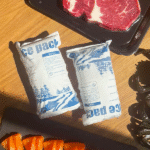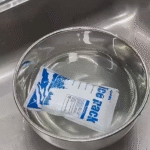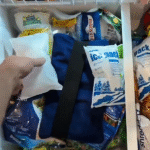Mylar vs Kraft Dry Ice Bags: Which Should You Use?
Dry ice turns to CO₂ gas as it warms, so packaging must allow the gas to escape safely. Mylar and kraft dry ice bags take opposite approaches: Mylar traps gases unless vented; kraft paper naturally breathes. This guide shows which works best for your shipment type, safety standards, and sustainability goals.
-
How do Mylar vs Kraft dry ice bags control CO₂ release?
-
Which option fits 2025 compliance and safety requirements?
-
What are the durability, cost, and sustainability trade-offs?
-
How should you pack, vent, and label correctly for 24–72 h?
-
What 2025 trends affect Mylar vs Kraft bag design?
How Mylar vs Kraft Bags Handle CO₂
Key point: Mylar requires engineered venting or an open mouth; kraft multi-wall bags are naturally vent-friendly. Always maintain a gas path to avoid rupture.
Dry ice sublimates into CO₂ gas, expanding rapidly if trapped. Modern air-shipping standards specify that dry ice packaging must release gas freely. Folded kraft or micro-perforated film achieves this automatically, while Mylar must be modified or left open.
Vented options for pellets and blocks
-
Pellets: Micro-perforated film bags allow CO₂ to escape while containing debris.
-
Blocks: Multi-ply kraft dry ice bags, open-mouth and folded, are the safest option.
-
Hybrid: Kraft exterior with a film or foil liner balances strength and venting.
| Venting Option | Typical Format | How It Vents | What It Means |
|---|---|---|---|
| Open-mouth kraft bag | Block / cut | Naturally non-airtight | Safe default; simple fold seal. |
| Micro-perforated film | Pellets | Bleeds gas via holes | Debris control + ventilation. |
| Mylar (unsealed/vented) | Block or pellets | Deliberate vent or open edge | High barrier if vent path kept. |
Quick tips
-
Fold, don’t seal. Keep a visible vent channel to the headspace.
-
Pellets: Choose micro-perforated film for clean handling.
-
Blocks: Use kraft for simplicity and compliance.
Safety and Compliance in 2025
The safest bag is the one that vents by default. Kraft’s porous structure complies with CO₂-release requirements, while sealed Mylar pouches violate safety rules.
-
Mylar: Must be unsealed or vented; otherwise risks rupture.
-
Kraft: Naturally compliant; no extra venting steps required.
-
Labeling: Mark outer packages “Dry Ice,” UN 1845, and net weight (kg).
| Property | Mylar | Kraft | Best Use |
|---|---|---|---|
| Gas permeability | Very low | Moderate | Kraft is inherently safe |
| Moisture barrier | Excellent | Medium | Mylar for humid routes |
| Durability | High | Good | Mylar for automation lines |
| Label surface | Reflective | Writable | Kraft for quick labeling |
Cost and Operational Efficiency
Kraft bags cost less ($0.15–$0.30 ea) but degrade faster in humidity.
Mylar bags cost more ($0.40–$0.75 ea) but maintain temperature longer.
| Factor | Mylar | Kraft | Recommendation |
|---|---|---|---|
| Long routes | ✔ | — | Mylar |
| Short/medium routes | — | ✔ | Kraft |
| ESG goals | △ | ✔ | Kraft |
| Automation lines | ✔ | △ | Mylar |
Rule of thumb: Kraft for blocks and routine deliveries; Mylar for premium or long-haul shipments.
Packing Mylar vs Kraft Dry Ice Bags Correctly
-
Select the right inner bag: Kraft for blocks, micro-perforated film for pellets.
-
Never seal airtight: Leave or cut a vent path.
-
Use non-airtight outer shippers: Foam or EPS boxes with loose lids.
-
Label clearly: “Dry Ice,” UN 1845, and net kg.
-
Plan for sublimation: 5–10 lb per 24 h typical for insulated boxes.
| Scenario | Bag Type | Outer Container | Result |
|---|---|---|---|
| Retail block sales | Kraft (open-mouth) | Foam box | Fast, safe hand-off |
| Pellet courier | Micro-perforated film | EPS shipper | Debris control |
| Humid routes | Kraft + liner | Paper/foam hybrid | Moisture resistance |
Performance and Sustainability
Mylar: Reflects heat, slowing sublimation; durable but non-biodegradable.
Kraft: Breathable, recyclable, compostable; may absorb moisture.
| Category | Mylar | Kraft | Practical Meaning |
|---|---|---|---|
| Recyclability | Limited | High | Kraft supports ESG targets |
| Carbon footprint | Moderate | Low | Paper preferred for green ops |
| Durability | Excellent | Moderate | Mylar suits automation |
| Moisture control | Excellent | Fair | Kraft needs liners |
Takeaway: Kraft supports sustainability reports; Mylar protects temperature-critical goods.
2025 Packaging Trends
-
Hybrid materials: Paper–film composites combine venting and strength.
-
Smart sensors: Embedded monitors track temperature and CO₂.
-
Recyclable laminates: Bio-based PET and coated kraft options gain traction.
| Trend | Description | Impact |
|---|---|---|
| Engineered vents | Built-in paper or film vents | Simplifies compliance |
| Sensor integration | Real-time CO₂/temperature alerts | Reduces spoilage |
| Sustainable sourcing | FSC kraft + recycled PET | Enhances ESG scores |
FAQs
Can I seal Mylar around dry ice?
No. CO₂ buildup can burst the bag. Always leave a vent path.
Are kraft bags safer?
Yes, they’re naturally non-airtight, aligning with venting rules.
Which for pellets?
Micro-perforated film or unsealed Mylar with vent path.
How much dry ice per day?
Plan roughly 5–10 lb per 24 h depending on insulation.
Required labels?
Outer carton: “Dry Ice,” UN 1845, and Class 9 hazard mark.
Summary and Next Steps
-
Mylar: Long retention, strong barrier, requires venting.
-
Kraft: Breathable, eco-friendly, safer by default.
-
Best practice: Fold, don’t seal. Vent first, label second.
-
Action: Standardize both SKUs—kraft for blocks, vented film/Mylar for special lanes.
Next step: Talk with Tempk specialists to match bag type to route duration, humidity, and safety compliance.
About Tempk
Tempk engineers advanced cold-chain packaging—multi-wall kraft dry ice bags, vented film liners, and unsealed reflective bags for pharma, food, and lab logistics. We help clients meet compliance, ESG, and cost targets with validated venting and durability standards.
Call to Action:
Request a tailored SOP for your lane—bag type, vent check, and labeling guide in one page.

















